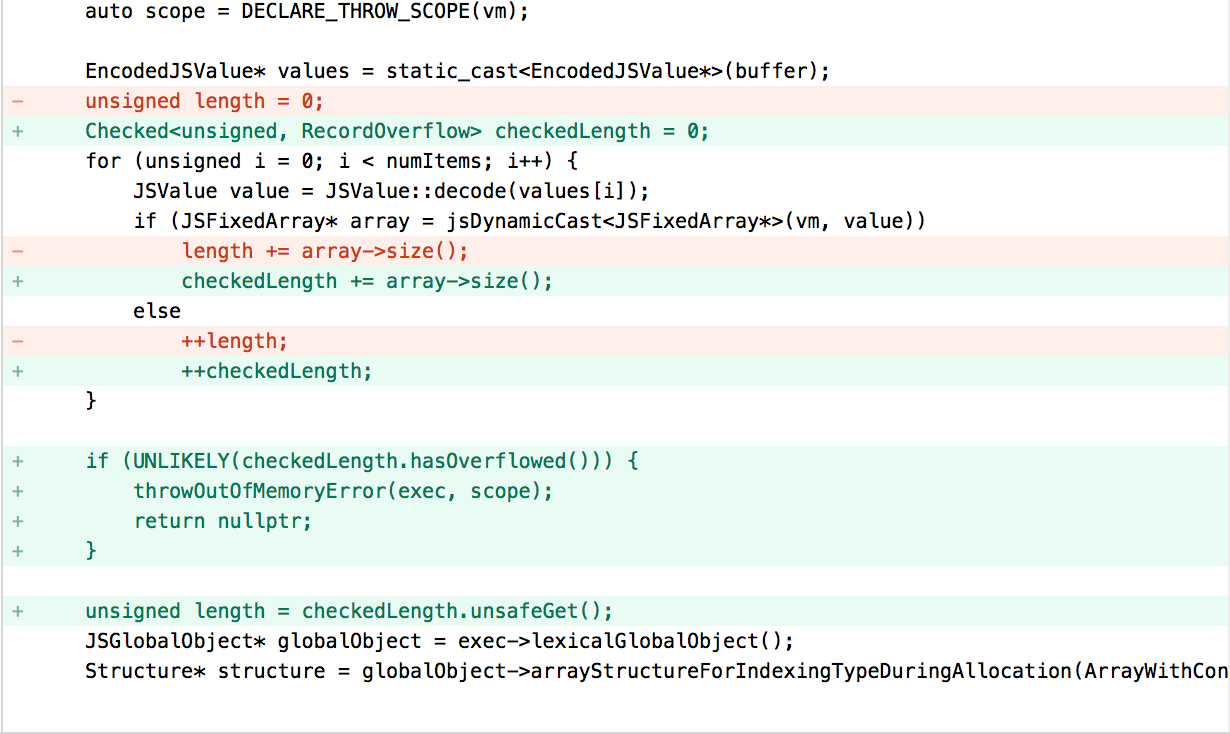0x00 : 前置知识
interpreter
DFG JIT
FLT JIT
总的来说过程就是把源码生成字节码,接着变成 DFG CPS IR,再就是 DFG SSA IR,最后成 B3 的 IR,JavaScript 的动态性就是在这些过程中一步步被消除掉的。
首先了解 javascript展开语法:
1 2 3 4 ES6的新特性: 展开语法(Spread syntax), 可以在函数调用/数组构造时, 将数组表达式或者string在语法层面展开; 还可以在构造字面量对象时, 将对象表达式按key-value的方式展开。 (译者注: 字面量一般指 [1, 2, 3] 或者 {name: "mdn"} 这种简洁的构造方式)
1 2 3 var a = [1 , 2 , 3 ];console .log(...a);
0x01 : 漏洞信息 经典的jit洞 git commit : 61dbb71d92f6a9e5a72c5f784eb5ed11495b3ff7
1 2 let a = new Array (0x7fffffff );let hax = [13 , 37 , ...a, ...a];
PoC中,hax数组的长度,需要计算,根据展开array a去计算,jit中这部分实现出了问题。
0x02 : 漏洞分析 Exploiting an integer overflow with array spreading (WebKit)
1 2 3 4 5 6 7 8 9 10 11 12 13 14 15 16 17 18 19 20 21 22 23 24 25 26 27 28 29 30 31 32 33 34 35 36 37 38 39 40 41 42 43 44 45 46 47 48 SLOW_PATH_DECL(slow_path_new_array_with_spread) { BEGIN(); int numItems = pc[3 ].u.operand; ASSERT(numItems >= 0 ); const BitVector& bitVector = exec->codeBlock()->unlinkedCodeBlock()->bitVector(pc[4 ].u.unsignedValue); JSValue* values = bitwise_cast<JSValue*>(&OP(2 )); unsigned arraySize = 0 ; for (int i = 0 ; i < numItems; i++) { if (bitVector.get(i)) { JSValue value = values[-i]; JSFixedArray* array = jsCast<JSFixedArray*>(value); arraySize += array ->size(); } else arraySize += 1 ; } JSGlobalObject* globalObject = exec->lexicalGlobalObject(); Structure* structure = globalObject->arrayStructureForIndexingTypeDuringAllocation(ArrayWithContiguous); JSArray* result = JSArray::tryCreateForInitializationPrivate(vm, structure, arraySize); CHECK_EXCEPTION(); unsigned index = 0 ; for (int i = 0 ; i < numItems; i++) { JSValue value = values[-i]; if (bitVector.get(i)) { JSFixedArray* array = jsCast<JSFixedArray*>(value); for (unsigned i = 0 ; i < array ->size(); i++) { RELEASE_ASSERT(array ->get(i)); result->initializeIndex(vm, index, array ->get(i)); ++index; } } else { result->initializeIndex(vm, index, value); ++index; } } RETURN(result); }
size 是一个 unsigned ,可以整数溢出。JSObject::initializeIndex无任何边界检查:
1 2 3 4 5 6 7 8 9 10 case ALL_CONTIGUOUS_INDEXING_TYPES: { ASSERT(i < butterfly->publicLength()); ASSERT(i < butterfly->vectorLength()); butterfly->contiguous()[i].set (vm, this , v); break ; }
所以poc按照以上代码逻辑之行的话,会分配一个size是0的array,但是却拷贝了 2147483647 * 2 + 2 即 0x7fffffff * 2 + 2 个数据进去,导致堆溢出。
看commit 1 git log -g --grep="169780"
或者直接sourcetree搜索
这个洞在三个jit阶段都有体现,所以补了多个地方:LLint, DFG JIT, FTL JIT
基本上都是,计算新array的length从简单粗暴的计算,改成增加了length check的计算。
0x03 : 利用 TODO
0x04 : 参考 Exploiting an integer overflow with array spreading (WebKit)
深入剖析 WebKit

